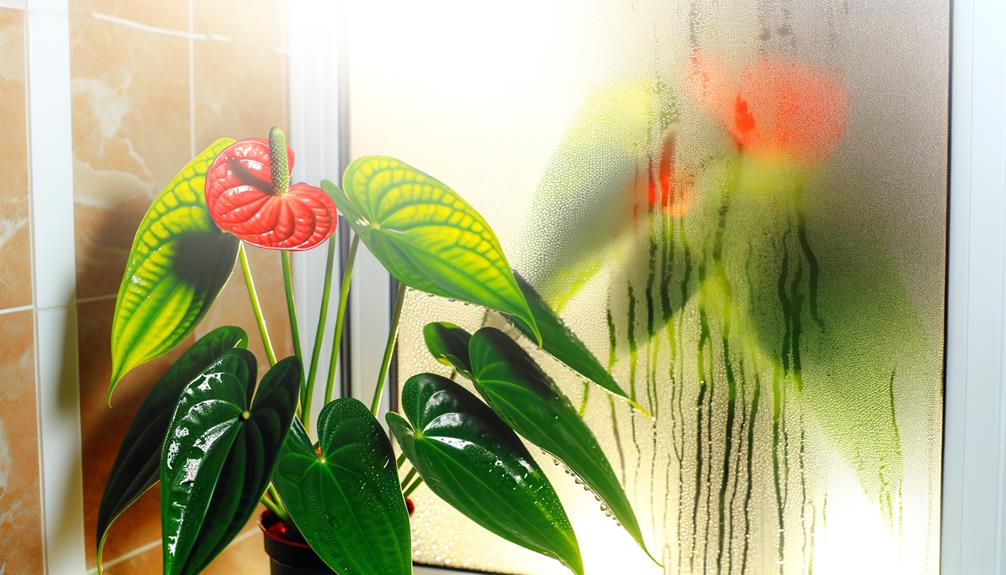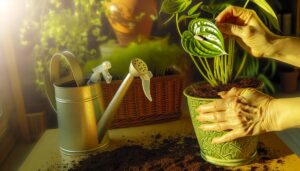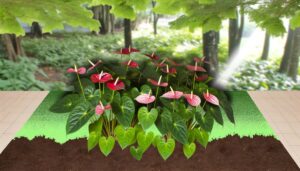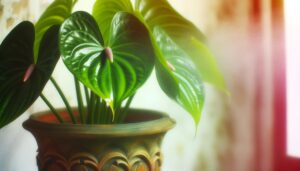Anthurium Plant Growth Boost: Best Bathroom Humidity Tips
To maximize your Anthurium plant's growth, keep your bathroom's moisture levels between 70-80%. Use a digital hygrometer to monitor levels accurately.
A nearby humidifier guarantees consistent moisture, while shower steam naturally boosts humidity. Choose a well-lit bathroom with good ventilation to prevent fungal growth.
Avoid placing the plant in direct airflow, and mist the leaves regularly to maintain hydration. Clean the leaves weekly to remove dust, and use filtered, tepid water for watering.
Guarantee your bathroom environment provides consistent humidity and the right light conditions, as these are critical for your Anthurium's health and growth. Discover more fascinating care tips ahead.

Key Takeaways
- Use a humidifier to maintain bathroom humidity levels between 70-80% for optimal Anthurium growth.
- Utilize shower steam to naturally boost ambient humidity and support Anthurium health.
- Ensure proper bathroom ventilation with an exhaust fan to prevent fungal diseases and manage humidity.
- Place a digital hygrometer near the plant to monitor and adjust humidity levels accurately.
- Position the Anthurium away from direct airflow to maintain consistent humidity and avoid stress.
Optimal Humidity Levels
For ideal growth, Anthurium plants require humidity levels consistently maintained between 70% and 80%. You'll need to monitor humidity with a hygrometer, ensuring accurate readings.
High humidity supports the plant's epiphytic nature, enabling better nutrient uptake through aerial roots. If humidity drops below 70%, the plant's growth rate decreases, and its leaves may develop brown tips or edges. Conversely, levels above 80% can promote fungal diseases.
To achieve this balance, use a humidifier or place the plant on a tray filled with water and pebbles, making sure the pot's base doesn't touch the water. Regular misting also helps, but avoid wetting the leaves excessively.
Consistency is key; abrupt changes can stress the plant, hindering its growth.
Choosing the Right Bathroom
Selecting the right bathroom involves assessing factors like natural light availability, ventilation efficiency, and space allocation for ideal Anthurium plant growth.
You'll need to weigh various elements to guarantee your Anthurium thrives:
- Natural Light: Bathrooms with windows provide indirect sunlight, which is essential for Anthuriums. Aim for filtered light, avoiding direct sun exposure.
- Ventilation: Proper ventilation prevents mold and maintains humidity levels. Make sure that your bathroom has an exhaust fan or a window that can be opened.
- Space Allocation: Sufficient space allows for optimal air circulation around the plant. Avoid overcrowding to reduce stress on the plant.
Using a Humidifier
Using a humidifier can improve the growth environment for your Anthurium by maintaining ideal humidity levels between 70-80%.
Place the humidifier near the plant but make sure it doesn't cause direct water accumulation on the leaves.
Choose an energy-efficient model to maintain humidity consistently while reducing electricity usage.
Optimal Humidity Levels
Maintaining ideal humidity levels for your Anthurium, ideally between 70-80%, can be effectively achieved by using a high-quality humidifier. A humidifier not only guarantees consistent moisture but also replicates the plant's natural environment. You'll need to monitor and adjust the device to maintain optimal conditions.
Consider the following benefits:
- Precision Control: Modern humidifiers allow you to set precise humidity levels, ensuring your Anthurium never encounters stress from dry air.
- Consistent Output: Unlike sporadic misting, a humidifier provides a continuous supply of moisture.
- Healthier Growth: Steady humidity levels promote strong root systems and vibrant foliage.
Placement and Maintenance
Proper placement of your humidifier is crucial to maximize its efficiency and ensure your Anthurium flourishes. Position the humidifier close to your Anthurium, ideally within a 3-foot radius, making sure it's raised slightly to allow even mist distribution.
Avoid pointing the mist directly at the plant, as excess moisture may lead to fungal problems. Regularly clean the humidifier to prevent mold and bacteria buildup; a weekly rinse with a mixture of water and white vinegar is effective.
Additionally, monitor the room's humidity level with a hygrometer, targeting a consistent 60-80% relative humidity. Refill the humidifier with distilled or demineralized water to reduce mineral deposits and maintain ideal vapor quality for your Anthurium's delicate microclimate.
Energy-Efficient Models
Optimizing your Anthurium's environment also involves selecting energy-efficient humidifier models that maintain humidity levels without significantly increasing your energy consumption. Look for units with a high Energy Star rating, which guarantees efficient operation.
Consider models incorporating advanced features like:
- Ultrasonic Technology: Uses high-frequency sound vibrations to produce a fine mist, consuming less power.
- Smart Sensors: Automatically adjust humidity levels based on real-time measurements, optimizing energy usage.
- Timer Functions: Allow you to schedule operation during specific periods, reducing unnecessary use.
These options guarantee your Anthurium thrives without a steep energy bill.
Additionally, maintaining your humidifier by regularly cleaning and replacing filters ensures it runs efficiently, further conserving energy while providing ideal conditions for your plant.
Shower Steam Benefits
When you take a shower, the steam greatly enhances the humidity levels in your bathroom, creating an ideal microenvironment for your Anthurium.
This natural moisture distribution guarantees that the plant receives consistent humidity, which is essential for its best growth conditions.
Consequently, your Anthurium can thrive, displaying vibrant leaves and robust health.
Enhanced Humidity Levels
Shower steam immensely boosts ambient humidity levels, creating a perfect microenvironment for Anthurium plants to thrive. When you take a hot shower, the steam disperses water vapor into the air, greatly raising the relative humidity.
This increase in moisture can benefit Anthuriums by:
- Reducing Transpirational Stress: High humidity minimizes water loss from leaves, promoting better hydration.
- Supporting Best Growth: Elevated humidity levels are essential for photosynthesis and nutrient uptake.
- Preventing Leaf Browning: Consistent moisture helps maintain leaf turgidity and health.
Natural Moisture Distribution
Harnessing the steam from your daily showers guarantees a consistent and even distribution of moisture throughout the bathroom, creating an ideal environment for Anthurium plants to flourish.
Steam increases ambient humidity levels, which Anthuriums require for optimal health. When hot water evaporates, it disperses microscopic water droplets into the air. These droplets settle on plant leaves, mimicking their natural tropical habitat. This process also maintains a stable microclimate, reducing stress on the plant.
Additionally, consistent exposure to steam helps prevent common issues such as leaf browning and tip burn, which are often caused by low humidity. By simply showering, you're ensuring a steady supply of moisture, fostering robust growth and vibrant blooms in your Anthurium plants.
Optimal Growth Conditions
Using the steam from your daily showers greatly increases the ambient humidity, creating ideal growth conditions for Anthurium plants. This perpetual moisture boost mimics their natural tropical habitat, promoting vigorous growth and vibrant blooms.
High humidity levels facilitate peak stomatal function, enabling efficient gas exchange and nutrient absorption.
To maximize the benefits, consider these strategies:
- Positioning: Place your Anthurium near the shower but away from direct water spray.
- Ventilation: Ensure sufficient airflow to prevent mold growth while maintaining humidity.
- Consistency: Regularly monitor humidity levels, aiming for a steady 60-80%.
Ventilation Balance
Achieving the right balance in bathroom ventilation is important for maintaining ideal moisture levels that keep your Anthurium thriving. Make sure your bathroom has moderate air exchange without excessive drafts.
Utilize an exhaust fan on a timer to regulate moisture, especially after showers, to prevent mold. Aim for 60-80% relative moisture, as too much ventilation can dry the air, while too little can cause stagnation, increasing fungal risks.
Position your Anthurium away from direct airflow from vents or fans. Regularly measure moisture with a hygrometer and adjust ventilation settings accordingly.
Balancing these elements will create a stable microenvironment, promoting best growth conditions and preventing potential issues related to improper moisture levels.
Grouping Plants Together
When you group your Anthurium plants together, you create a microenvironment where humidity levels are naturally elevated due to collective transpiration. This shared microclimate benefits all the plants by maintaining consistent moisture levels, which is essential for best growth.
Increased Humidity Levels
Grouping multiple Anthurium plants together can greatly elevate the humidity levels in your bathroom, creating a more conducive microenvironment for their growth. By clustering these plants, you capitalize on their natural transpiration process, which releases moisture into the air. This increase in ambient humidity can have several scientific benefits:
- Enhanced Stomatal Function: Higher humidity improves stomatal conductance, facilitating better gas exchange and photosynthesis.
- Reduced Transpirational Stress: Elevated moisture levels mitigate water loss, preventing leaf desiccation and promoting overall plant health.
- Optimal Growth Conditions: Consistent high humidity supports robust cellular processes, leading to lush foliage and vibrant blooms.
Shared Microclimate Benefits
By clustering multiple Anthurium plants, you create a shared microclimate that maximizes humidity retention and fosters synergistic growth dynamics.
This grouping effect enhances transpiration, where moisture released by one plant is absorbed by others, reinforcing a high-humidity microenvironment. This mutual benefit reduces water loss, ensuring each plant's stomata remain open for best gas exchange and nutrient uptake.
Additionally, the microclimate stabilizes temperature fluctuations, providing a consistent environment that mitigates stress factors. You'll notice improved leaf turgor and vibrant blooms as the plants collectively maintain ideal conditions.
Employing this strategy leverages natural plant processes, making it a scientifically sound approach to enhancing Anthurium growth and vigor.
Watering Techniques
Implementing these methods guarantees proper watering techniques for your Anthurium involves maintaining consistent soil moisture without causing waterlogging, which can lead to root rot. Use tepid, filtered water to avoid shocking the roots and ensure peak absorption. Water your Anthurium when the top inch of soil feels dry to the touch.
Check drainage: Make sure the pot has sufficient drainage holes.
Water uniformly: Pour water evenly around the base to avoid dry spots.
Monitor frequency: Adjust watering frequency based on seasonal changes and bathroom humidity levels.
Implementing these techniques guarantees your Anthurium receives the right amount of water, promoting healthy growth and vibrant blooms. Remember, over-watering is just as harmful as under-watering, so balance is key.
DIY Humidity Trays
Maintaining ideal humidity in your bathroom can greatly enhance Anthurium growth, and creating DIY humidity trays is an effective method to achieve this.
Start by selecting a shallow tray that fits under your plant pot. Fill the tray with a layer of pebbles, ensuring they're evenly distributed.
Next, add water to the tray, stopping just below the top of the pebbles to prevent direct contact with the pot's base. This setup encourages evaporation, increasing ambient humidity around your Anthurium. Regularly check water levels to maintain consistent humidity.
The pebbles also prevent root rot by keeping the container elevated. Implementing DIY humidity trays can significantly optimize the microclimate, fostering robust Anthurium growth in your bathroom.
Regular Misting
Regular spraying can effectively heighten humidity levels around your Anthurium, promoting ideal growth conditions. By mimicking their native tropical environment, you help the plant maintain peak hydration and nutrient absorption. Use a fine mist sprayer to ensure uniform coverage without saturating the soil, which can lead to root rot.
Frequency: Spray your Anthurium every 2-3 days, particularly in dry seasons or when indoor humidity drops below 60%.
Water Quality: Use distilled or rainwater to avoid mineral buildup on leaves, which can hinder photosynthesis.
Timing: Spray during the early morning to allow the leaves to dry before nightfall, reducing the risk of fungal growth.
Leaf Cleaning Routine
A consistent leaf cleaning schedule is crucial for maintaining your Anthurium's overall health and maximizing its photosynthetic efficiency. Dust and grime can block light absorption, reducing photosynthesis and hindering growth. Use a damp, soft cloth to gently wipe each leaf, making sure you remove all residues. Avoid harsh chemicals; instead, go for a mild soap solution. Frequency matters—clean leaves every two weeks to ensure peak health.
Here's a quick reference table for your leaf cleaning schedule:
| Task | Frequency | Method |
|---|---|---|
| Dusting | Weekly | Soft, dry cloth |
| Deep cleaning | Bi-weekly | Damp cloth, mild soap |
| Inspect for pests | Every cleaning | Visual check, eliminate |
| Rinse soap residues | After deep clean | Lukewarm water rinse |
Regular maintenance will keep your Anthurium flourishing.
Temperature Control
After verifying that your Anthurium's leaves are clean and free from debris, you need to focus on maintaining an optimal temperature range of 70-85°F (21-29°C) to promote vigorous growth and prevent stress. Temperature fluctuations can disrupt the plant's metabolic processes, leading to growth inhibition or leaf damage. Use a digital thermometer to monitor the temperature accurately.
Additionally, avoid placing the plant near air vents or drafts, which can cause temperature instability.
Key temperature control tips include:
- Consistent Monitoring: Regularly check the temperature to ensure stability.
- Avoid Extreme Conditions: Keep the plant away from direct sunlight and cold drafts.
- Use Insulating Materials: Place the plant on a surface that doesn't retain cold, like a wooden table.
These practices will help maintain a stable environment conducive to Anthurium health.
Monitoring Humidity
Humidity levels play a crucial role in the growth and health of your Anthurium, requiring diligent monitoring to make sure they stay within the ideal range of 60-80%.
Use a digital hygrometer to measure the humidity accurately. Place the hygrometer near the Anthurium, avoiding direct water contact. Regularly check the readings to ensure uniformity.
If the humidity drops below 60%, consider using a humidifier or placing a water tray with pebbles near the plant. Conversely, if it exceeds 80%, improve bathroom ventilation.
Conclusion
By integrating these strategies, your bathroom can become a tropical rainforest for your anthurium. Like Newton discovered gravity, you'll uncover the magic of best humidity.
Embrace shower steam, use a humidifier, and guarantee proper ventilation. Regular misting and leaf cleaning will mimic nature's touch. Maintain a constant temperature, and monitor humidity levels carefully.
With these scientific techniques, your anthurium's growth will flourish, turning your bathroom into a botanical sanctuary.






